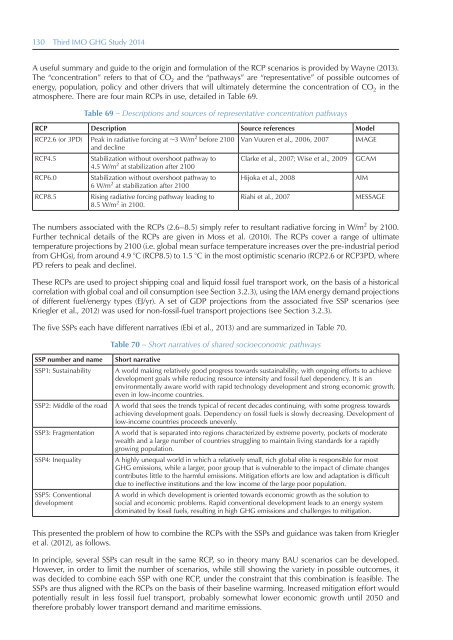MnrAq
MnrAq
MnrAq
You also want an ePaper? Increase the reach of your titles
YUMPU automatically turns print PDFs into web optimized ePapers that Google loves.
130 Third IMO GHG Study 2014<br />
A useful summary and guide to the origin and formulation of the RCP scenarios is provided by Wayne (2013).<br />
The “concentration” refers to that of CO 2 and the “pathways” are “representative” of possible outcomes of<br />
energy, population, policy and other drivers that will ultimately determine the concentration of CO 2 in the<br />
atmosphere. There are four main RCPs in use, detailed in Table 69.<br />
Table 69 – Descriptions and sources of representative concentration pathways<br />
RCP Description Source references Model<br />
RCP2.6 (or 3PD) Peak in radiative forcing at ~3 W/m 2 before 2100<br />
and decline<br />
RCP4.5<br />
RCP6.0<br />
RCP8.5<br />
Stabilization without overshoot pathway to<br />
4.5 W/m 2 at stabilization after 2100<br />
Stabilization without overshoot pathway to<br />
6 W/m 2 at stabilization after 2100<br />
Rising radiative forcing pathway leading to<br />
8.5 W/m 2 in 2100.<br />
Van Vuuren et al., 2006, 2007<br />
Clarke et al., 2007; Wise et al., 2009<br />
Hijoka et al., 2008<br />
Riahi et al., 2007<br />
IMAGE<br />
GCAM<br />
AIM<br />
MESSAGE<br />
The numbers associated with the RCPs (2.6–8.5) simply refer to resultant radiative forcing in W/m 2 by 2100.<br />
Further technical details of the RCPs are given in Moss et al. (2010). The RCPs cover a range of ultimate<br />
temperature projections by 2100 (i.e. global mean surface temperature increases over the pre-industrial period<br />
from GHGs), from around 4.9 °C (RCP8.5) to 1.5 °C in the most optimistic scenario (RCP2.6 or RCP3PD, where<br />
PD refers to peak and decline).<br />
These RCPs are used to project shipping coal and liquid fossil fuel transport work, on the basis of a historical<br />
correlation with global coal and oil consumption (see Section 3.2.3), using the IAM energy demand projections<br />
of different fuel/energy types (EJ/yr). A set of GDP projections from the associated five SSP scenarios (see<br />
Kriegler et al., 2012) was used for non-fossil-fuel transport projections (see Section 3.2.3).<br />
The five SSPs each have different narratives (Ebi et al., 2013) and are summarized in Table 70.<br />
Table 70 – Short narratives of shared socioeconomic pathways<br />
SSP number and name<br />
SSP1: Sustainability<br />
SSP2: Middle of the road<br />
SSP3: Fragmentation<br />
SSP4: Inequality<br />
SSP5: Conventional<br />
development<br />
Short narrative<br />
A world making relatively good progress towards sustainability, with ongoing efforts to achieve<br />
development goals while reducing resource intensity and fossil fuel dependency. It is an<br />
environmentally aware world with rapid technology development and strong economic growth,<br />
even in low-income countries.<br />
A world that sees the trends typical of recent decades continuing, with some progress towards<br />
achieving development goals. Dependency on fossil fuels is slowly decreasing. Development of<br />
low-income countries proceeds unevenly.<br />
A world that is separated into regions characterized by extreme poverty, pockets of moderate<br />
wealth and a large number of countries struggling to maintain living standards for a rapidly<br />
growing population.<br />
A highly unequal world in which a relatively small, rich global elite is responsible for most<br />
GHG emissions, while a larger, poor group that is vulnerable to the impact of climate changes<br />
contributes little to the harmful emissions. Mitigation efforts are low and adaptation is difficult<br />
due to ineffective institutions and the low income of the large poor population.<br />
A world in which development is oriented towards economic growth as the solution to<br />
social and economic problems. Rapid conventional development leads to an energy system<br />
dominated by fossil fuels, resulting in high GHG emissions and challenges to mitigation.<br />
This presented the problem of how to combine the RCPs with the SSPs and guidance was taken from Kriegler<br />
et al. (2012), as follows.<br />
In principle, several SSPs can result in the same RCP, so in theory many BAU scenarios can be developed.<br />
However, in order to limit the number of scenarios, while still showing the variety in possible outcomes, it<br />
was decided to combine each SSP with one RCP, under the constraint that this combination is feasible. The<br />
SSPs are thus aligned with the RCPs on the basis of their baseline warming. Increased mitigation effort would<br />
potentially result in less fossil fuel transport, probably somewhat lower economic growth until 2050 and<br />
therefore probably lower transport demand and maritime emissions.


